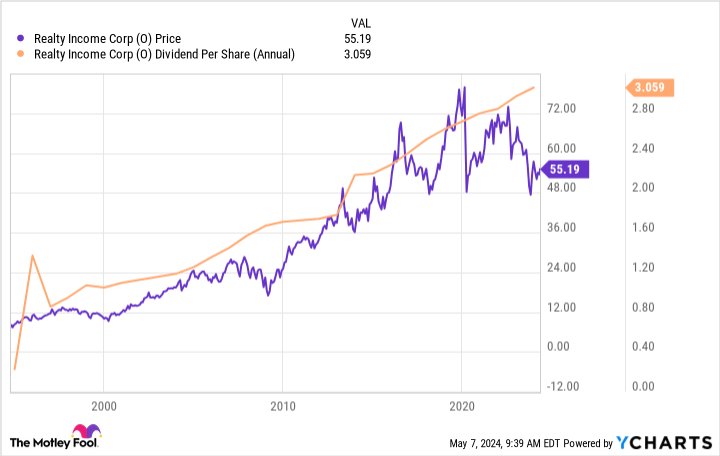Where Will High-Yielding Realty Income Be in 5 Years?
With a $47 billion market cap, Realty Income (NYSE: O) is a giant company relative to its next-closest peer, which is about a quarter of that size. A very real question for investors should be: What can a company that's already the 800-pound gorilla of the industry do from here? The answer is keep growing, and likely rewarding investors with more dividends. Here's why.
What you are buying with Realty Income
Realty Income is the largest net-lease real estate investment trust (REIT). A net lease requires the tenant to pay most property-level operating costs. Usually each property is occupied by just one tenant. While any individual asset is high risk given there's only a single tenant, across a large portfolio the risk is fairly low because net-lease REITs avoid most property-level costs and operating issues. Realty Income has over 15,400 properties, which, like its market cap, makes it the biggest player in the net-lease space.

On top of being large, Realty Income is also financially strong. That's evidenced by its investment-grade balance sheet, and is punctuated by a 30-year string of annual dividend increases. Although most of the REIT's properties are retail focused, it also has exposure to industrial assets and some more unique property types like casinos and data centers. On top of that diversification, it has operations in Europe.
Realty Income is big, reasonably diversified, and financially strong, and its 5.5% dividend yield happens to be near the high end of its historical range over the past decade. In other words, it looks like Realty Income is on sale today.
What about Realty Income's future?
To be fair, Realty Income is not and has never really been a growth stock, so slow and steady is what investors should expect. For example, the average annual dividend growth rate over the past 30 years is a modest 4.3%. That, however, is more than enough to keep the buying power of the dividend ahead of the historical growth rate of inflation. Or, to put that another way, the buying power of the dividend has steadily increased over time. There's no reason to think that this is going to change.
For starters, Realty Income believes that its addressable market in the United States is around $5.4 trillion dollars. At this point, public REITs only account for around $210 billion of that. So there's plenty of room for growth in the United States. The European net-lease market is less well developed, but even larger at roughly $8.5 trillion. Public net-lease REITs account for less than 1% of that total. That's plenty of runway for Realty Income to keep buying properties.
Meanwhile, it is important to note that Realty Income's size comes with distinct advantages on the capital-raising front. Because it is so big, it generally has easier access to both the debt and equity markets, and coupled with its investment-grade credit rating, that means lower costs. So Realty Income can bid aggressively on properties and still turn a profit.
It can also take on deals that would be hard for smaller peers to swallow. That gives it a leg up in Europe, where companies are often looking to sell multiple properties at one time. And it allows Realty Income to acquire large portfolios of assets in the U.S. market in one big deal as opposed to having to work on multiple small transactions. But there's another factor to consider here as well: Realty Income is big enough to act as an industry consolidator. In fact, it has bought two competitors in recent years.
Bigger is better for Realty Income
Realty Income is not an exciting stock. It is built to be boring and reliable. But don't think that being the biggest net-lease REIT is a headwind to future growth. The truth is it could actually be a tailwind. This dividend stock with a historically attractive yield will likely just get bigger and even more attractive over the next five years. If you buy it today, you can lock in that tasty yield.
Should you invest $1,000 in Realty Income right now?
Before you buy stock in Realty Income, consider this:
The Motley Fool Stock Advisor analyst team just identified what they believe are the 10 best stocks for investors to buy now… and Realty Income wasn’t one of them. The 10 stocks that made the cut could produce monster returns in the coming years.
Consider when Nvidia made this list on April 15, 2005... if you invested $1,000 at the time of our recommendation, you’d have $543,758!*
Stock Advisor provides investors with an easy-to-follow blueprint for success, including guidance on building a portfolio, regular updates from analysts, and two new stock picks each month. The Stock Advisor service has more than quadrupled the return of S&P 500 since 2002*.
*Stock Advisor returns as of May 6, 2024
Reuben Gregg Brewer has positions in Realty Income. The Motley Fool has positions in and recommends Realty Income. The Motley Fool has a disclosure policy.
Where Will High-Yielding Realty Income Be in 5 Years? was originally published by The Motley Fool

